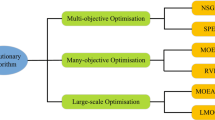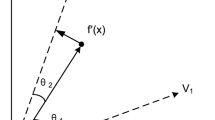Abstract
Having successfully handled many-objective optimization problems with box constraints only by using VaEA, a vector angle based many-objective evolutionary algorithm in our precursor study, this paper extended VaEA to solve generic constrained many-objective optimization problems. The proposed algorithm (denoted by CVaEA) differs from the original one mainly in the mating selection and the environmental selection, which are made suitable in the presence of infeasible solutions. Furthermore, we suggest a set of new constrained many-objective test problems which have different ranges of function values for all the objectives. Compared with normalized problems, this set of scaled ones is more applicable to test an algorithm’s performance. This is due to the nature property of practical problems being usually far from normalization. The proposed CVaEA was compared with two latest constrained many-objective optimization methods on the proposed test problems with up to 15 objectives, and on a constrained engineering problem from practice. It was shown by the simulation results that CVaEA could find a set of well converged and properly distributed solutions, and, compared with its competitors, obtained a better balance between convergence and diversity. This, and the original VaEA paper, together demonstrate the usefulness and efficiency of vector angle based algorithms for handling both constrained and unconstrained many-objective optimization problems.








Similar content being viewed by others
References
Asafuddoula M, Ray T, Sarker R (2015) A decomposition-based evolutionary algorithm for many objective optimization. IEEE Trans Evol Comput 19(3):445–460
Bandyopadhyay S, Mukherjee A (2015) An algorithm for many-objective optimization with reduced objective computations: a study in differential evolution. IEEE Trans Evol Comput 19(3):400–413
Bosman P, Thierens D (2003) The balance between proximity and diversity in multiobjective evolutionary algorithms. IEEE Trans Evol Comput 7(2):174–188
Cheng J, Yen GG, Zhang G (2015) A many-objective evolutionary algorithm with enhanced mating and environmental selections. IEEE Trans Evol Comput 19(4):592–605
Corne DW, Jerram NR, Knowles JD, Oates MJ, Martin J (2001) PESA-II: region-based selection in evolutionary multiobjective optimization Proceedings of the genetic and evolutionary computation conference (GECCO2001). Morgan Kaufmann Publishers, pp 283–290
Deb K, Jain H (2014) An evolutionary many-objective optimization algorithm using reference-point based nondominated sorting approach, part I: solving problems with box constraints. IEEE Trans Evol Comput 18 (4):577–601
Deb K, Jain H (2014) An evolutionary many-objective optimization algorithm using reference-point based nondominated sorting approach, part I: solving problems with box constraints. IEEE Trans Evol Comput 18 (4):577–601
Deb K, Pratap A, Agarwal S, Meyarivan T (2002) A fast and elitist multiobjective genetic algorithm: NSGA-II. IEEE Trans Evol Comput 6(2):182–197
Deb K, Thiele L, Laumanns M, Zitzler E (2005) Scalable test problems for evolutionary multiobjective optimization. In: Abraham A, Jain L, Goldberg R. (eds) Evolutionary multiobjective optimization, advanced information and knowledge processing. Springer, London, pp 105–145, doi: 10.1007/1-84628-137-7_6
Derrac J, Garcia S, Molina D, Herrera F (2011) A practical tutorial on the use of nonparametric statistical tests as a methodology for comparing evolutionary and swarm intelligence algorithms. Swarm Evol Comput 1(7):3–18
Durillo JJ, Nebro AJ (2011) jMetal: a java framework for multi-objective optimization. Adv Eng Softw 42:760–771
Fu G, Kapelan Z, Kasprzyk J, Reed P (2013) Optimal design of water distribution systems using many-objective visual analytics. J Water Resour Plan Manag 139:624–33
Jain H, Deb K (2014) An evolutionary many-objective optimization algorithm using reference-point based nondominated sorting approach, part II: handling constraints and extending to an adaptive approach. IEEE Trans Evol Comput 18(4):602– 622
Jan M, Zhang Q (2010) Moea/d for constrained multiobjective optimization: some preliminary experimental results UK workshop on computational intelligence (UKCI), pp 1–6
Jensen MT (2003) Reducing the run-time complexity of multiobjective EAs: the NSGA-II and other algorithms. IEEE Trans Evol Comput 7(5):503–515
Li K, Deb K, Zhang Q, Kwong S (2014) Efficient non-domination level update approach for steady-state evolutionary multiobjective optimization. Tech. Rep. 2014014, Department of Electtrical and Computer Engineering, Michigan State University, East Lansing, USA
Knowles J, Corne D (1999) The pareto archived evolution strategy: a new baseline algorithm for pareto multiobjective optimisation Proceeding of congress on evolutionary computation, CEC’99, vol 1. IEEE, pp 98–105
Li B, Li J, Tang K, Yao X (2015) Many-objective evolutionary algorithms: a survey. ACM Comput Surv 48(1):1–35
Li H, Zhang Q (2009) Multiobjective optimization problems with complicated pareto sets, MOEA/D and NSGA-II. IEEE Trans Evol Comput 13(2):284–302
Li K, Deb K, Zhang Q, Kwong S (2015) An evolutionary many-objective optimization algorithm based on dominance and decomposition. IEEE Trans Evol Comput 19(5):694–716
Li M, Yang S, Liu X (2015) Bi-goal evolution for many-objective optimization problems. Artif Intell 228:45–65
Lygoe RJ, Cary M, Fleming PJ (2013) A real-world application of a many-objective optimisation complexity reduction process Evolutionary multi-criterion optimization, lecture notes in computer science, vol 7811. Springer, pp 641–655
Li M, Yang S, Liu X (2014) Diversity comparison of pareto front approximations in many-objective optimization. IEEE Trans Cybern 44:2568–84
Praditwong K, Yao X (2006) A new multi-objective evolutionary optimization algorithm: the two-archive algorithm Proceedings of the computational intelligence and security, vol 1. Guangzhou, China, pp 286–291
Ray T, Tai K, Seow KC (2001) An evolutionary algorithm for multi-objective optimization. Eng Optim 33(3):399–424
Roy PC, Islam MM, Murase K, Yao X (2015) Evolutionary path control strategy for solving many-objective optimization problem. IEEE Trans Cybern 45(4):702–715
Wang H, Jiao L, Yao X (2015) Two_Arch2: an improved two-archive algorithm for many-objective optimization. IEEE Trans Evol Comput 19:524–541
Wang H, Jin Y, Yao X (2016) Diversity assessment in many-objective optimization. IEEE Trans Cybern 99:1–13. doi:10.1109/TCYB.2016.2550502
Wickramasinghe U, Carrese R, Li X (2010) Designing airfoils using a reference point based evolutionary many-objective particle swarm optimization algorithm IEEE congress on evolutionary computation (CEC). IEEE, pp 1–8
Xiang Y, Zhou Y, Li M, Chen Z (2017) A vector angle based evolutionary algorithm for unconstrained many-objective problems. IEEE Trans Evol Comput 21(1):131–152. doi:10.1109/TEVC.2016.2587808
Xiang Y, Zhou Y, Liu H (2015) An elitism based multi-objective artificial bee colony algorithm. Eur J Oper Res 245(1):168–193
Yang S, Li M, Liu X, Zheng J (2013) A grid-based evolutionary algorithm for many-objective optimization. IEEE Trans Evol Comput 17(5):721–736
Yuan Y, Xu H, Wang B, Yao X (2015) A new dominance relation based evolutionary algorithm for many-objective optimization. IEEE Trans Evol Comput 99:1. doi:10.1109/TEVC.2015.2420112
Zhang Q, Zhou A, Zhao S, Suganthan PN, Liu W, Tiwari S (2009) Multiobjective optimization test instances for the CEC 2009 special session and competition. University of Essex, Colchester, UK and Nanyang Technological University, Singapore, Special Session on Performance Assessment of Multi-Objective Optimization Algorithms, Technical Report
Zhang X, Tian Y, Jin Y (2015) A knee point-driven evolutionary algorithm for many-objective optimization. IEEE Trans Evol Comput 19(6):761–776
Zhou A, Jin Y, Zhang Q, Sendhoff B, Tsang E (2006) Combining model-based and genetics-based offspring generation for multi-objective optimization using a convergence criterion IEEE Congress on evolutionary computation (CEC 2006). IEEE, pp 892–899
Zitzler E, Laumanns M, Thiele L (2001) SPEA2: improving the strength pareto evolutionary algorithm. Tech. Rep., Computer Engineering and Networks Laboratory, Department of Electrical Engineering, Swiss Federal Institute of Technology, (ETH) Zurich, Switzerland
Acknowledgments
The authors are grateful to the anonymous reviewers for their insightful comments.
Author information
Authors and Affiliations
Corresponding author
Additional information
This paper is supported by the National Natural Science Foundation of China (Grant nos. 61472143 and 61673403), and the Scientific Research Special Plan of Guangzhou Science and Technology Programme (Grant no. 201607010045)
Rights and permissions
About this article
Cite this article
Xiang, Y., Peng, J., Zhou, Y. et al. An angle based constrained many-objective evolutionary algorithm. Appl Intell 47, 705–720 (2017). https://doi.org/10.1007/s10489-017-0929-9
Published:
Issue Date:
DOI: https://doi.org/10.1007/s10489-017-0929-9




